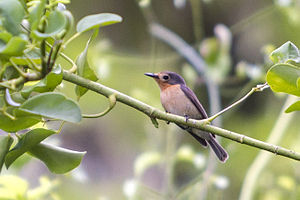Palau monarch
| Palau monarch | ||||||||||||
|---|---|---|---|---|---|---|---|---|---|---|---|---|

Palau monarch on Koror 2013. |
||||||||||||
| Systematics | ||||||||||||
|
||||||||||||
| Scientific name | ||||||||||||
| Myiagra erythrops | ||||||||||||
| Hartlaub & Finsch , 1868 |
The Palau monarch ( Palauisch : Charmelachull , Myiagra erythrops ; English Palau flycatcher ) is a songbird from the family of monarchs (Monarchidae). It is endemic to the Palau Islands .
features
The Palaumonarch is a small, short-tailed bird with a total length of 13-14 cm. It can stand up and the plumage is generally brownish with green and reddish shades. In the male, the forehead and front parting are reddish, gray from the back of the head to the back, the back and trunk are dull brown. The eye has an orange ring. On the underside, the reddish color extends to the chest and sides of the neck, but not as bright as on the throat. On the belly, the color turns whitish. The iris is dark brown. The bill and legs are bluish-gray and black. The female is usually smaller than the male. With him the vertex and back of the head are darker and the reddish color is less pronounced overall. Young animals are similar to females. The singing is a repeated series of 2–4 whistles in the same pitch with a duration of approx. 0.2–0.3 seconds, as well as a rapid series of trills. It also has a tough, scratchy reputation with only one syllable, comparable to the sounds of the related species M. pluto and M. oceanica.
Taxonomy and systematics
Molecular studies confirm the species character. The species is monotypical. Although some researchers consider it a subspecies of the Carolinenmonarch (Myiagra oceanica).
Habitat and Distribution
The species lives in subtropical and tropical lowland forests and in mangrove forests and on forest edges.
Way of life
Little is known about the way of life. It seems that the species prefers the mangrove forests; Standing bird.
food
The species lives on insects. It is mainly in the lower layers and also snatches insects out of the air. Occurs singly and in pairs.
Brood
Nests of breeding birds were seen in April. The nest is a thick-walled bowl made of plant material and lichen on horizontal branches in the undergrowth.
Protection status
The species is not threatened. It is widespread on the larger islands of Palau and the number of individuals seems to be stable.
Individual evidence
literature
- J. del Hoyo, A. Elliott, D. Christie: Handbook of the Birds of the World. , vol. 11: Old World Flycatchers to Old World Warblers. Lynx Edicions, Barcelona 2006.
- J. del Hoyo, A. Elliott, D. Christie: Palau Flycatcher (Myiagra erythrops). In: J. del Hoyo, A. Elliott, J. Sargatal, D. Christie, & E. de Juana (eds.): Handbook of the Birds of the World Alive. Lynx Edicions, Barcelona 2019. (retrieved from https://www.hbw.com/node/1343818 on August 28, 2019).
- MJ Andersen, PA Hosner, CE Filardi, & RG Moyle: Phylogeny of the monarch flycatchers reveals extensive paraphyly and novel relationships within a major Australo-Pacific radiation. In: Mol. Phylogenet. Evol. 83, 2015: 118-136.
- RH Baker: The avifauna of Micronesia. Its origin, evolution, and distribution. Univ. Kansas Publ. Mus. Nat. Hist. 3 (1), 1951: 1-359.
- P. Boesman: Notes on the vocalizations of Oceanic Flycatcher (Myiagra oceanica). In: HBW Alive Ornithological Note 192, 2016. URL: http://www.hbw.com/node/9321362016
- PH Fabre, M. Moltensen, J. Fjeldså, M. Irestedt, JP Lessard, & KA Jønsson: Multiple waves of colonization by monarch flycatchers (Myiagra, Monarchidae) across the IndoPacific and their implications for coexistence and speciation. In: J. Biogeogr. 41 (2), 2014: 274-286.
- HD Pratt, PL Bruner & DG Berrett: A Field Guide to the Birds of Hawaii and the Tropical Pacific. Princeton University Press, Princeton, New Jersey 1987.